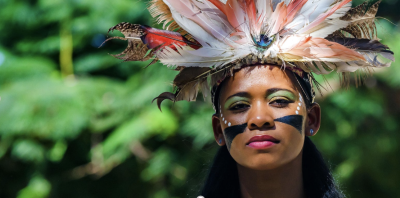
- This event has passed.
International Day of The World’s Indigenous People
August 9, 2022

“We are not myths of the past, ruins in the jungle, or zoos. We are people and we want to be respected, not to be victims of intolerance and racism.” – Rigoberta Menchu
There are over 476 million indigenous peoples living in 90 countries across the world, accounting for 6.2 per cent of the global population. Indigenous peoples have a vast diversity of unique cultures, traditions, languages and knowledge systems. They have a special relationship with their lands and hold diverse concepts of development based on their own worldviews and priorities. The International Day of the World’s Indigenous People is celebrated on August 9th each year to recognize the first UN working group on Indigenous Populations meeting in Geneva in 1982. The goal of this honoring and celebration is to further strengthen international cooperation for solving problems faced by indigenous peoples in areas such as culture, education, health, human rights, the environment, and social and economic development. The International Day of the World’s Indigenous People is celebrated by having people from different nations participating in activates such as educational presentations, classroom activities for youth, and performances/demonstrations to gain an appreciation and a better understanding of indigenous peoples.
How to celebrate International Day of The World’s Indigenous People in your department and at home:
Take moments to educate yourself, your family, and/or your team about the history and current culture of Indigenous People:
- Native Knowledge- 360
- Youth in Action- Indigenizing Hip-Hop
- Social Justice Books- An indigenous Peoples’ History of the United States for Young People
- History vs. Christopher Columbus – Alex Gendler
- Native Knowledge- 360
Donate to charities that support Indigenous people such as:
- LANDBACK
- Native American Rights Fund
- Warrior Women Project
- American Indian College Project
- Abolish Columbus Day Campaign
Plant some Native Plants:
- Rebuild local ecosystem by planting native plants in gardens/greenspace at home and in the community
To celebrate International Day of The World’s Indigenous People and the representation of our indigenous caregivers and community members, join us on August 11th and 12th at the Colby Campus Cafeteria.
Colby Campus International Day of The World’s Indigenous People Representation and Celebration Menu:
- Three Sisters Soup (corn, beans, squash)
- Salmon and wild rice
- Succotash
- Berry Bannock Bread Pudding
History of the Three Sisters Soup
” The reason why it’s called the Three Sister Soup is from the three main ingredients in the soup – Corn, Bean, and Squash. There was an old Iroquois legend of Sky Woman who fell from the sky. During this point in time, there was no land, only endless Ocean. The animals saw her falling from the sky and swam down and grabbed the soil from the surface and placed it on a Giant Turtle’s back. The turtle rose to the top of the Ocean and now Sky Woman had something to land on. She landed on Turtle which ended up becoming North America. Sky Woman was pregnant when she landed and gave birth to a daughter. That daughter later grew up and got pregnant by the “West Wind”. The daughter ended up having twin boys but unfortunately, she died during giving birth to these two boys. For the two boys to survive, Sky Woman developed a plan that would nourish the boys. She decided to bury her daughter in the “new earth” and from her grave grew three sacred plants. Those plants were corn, beans, and squash. These plants grew throughout the land and nourished the boys to keep them strong and healthy. Later these plants nourished everybody and helped with the survival of the Iroquois people. These three plants were grown together in one crop. They all actually work together to create a wonderful harvest for all that needs it. The First Sister, the bean, has a great ability to take nitrogen from the air which keeps the other two sisters healthy to grow strong. The corn stalks need nitrogen to grow, and they grow very tall. The beans use the height of the corn stalk to climb which holds all the plants together in unison. The Last sister, which is the Squash, is the protector. The Squash has big leaves which adds cover to the soil and keeps it moist. The cover keeps all the weeds from coming up and destroying parts of the crop. Another thing that the Squash does is protect the other sisters from animals coming up and eating the other sisters and keeps the harvest plentiful for all to enjoy. Now go on and make this awesome Three Sister Soup and also remember that this goes very well with fry bread. “
Learn more HERE
